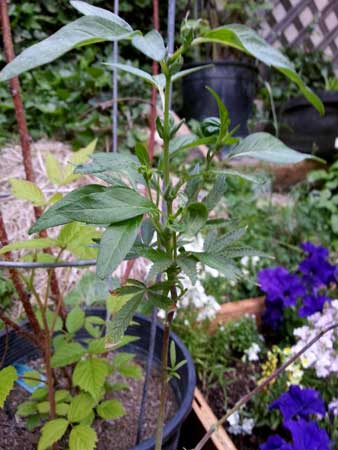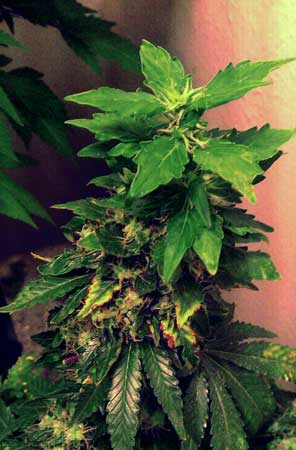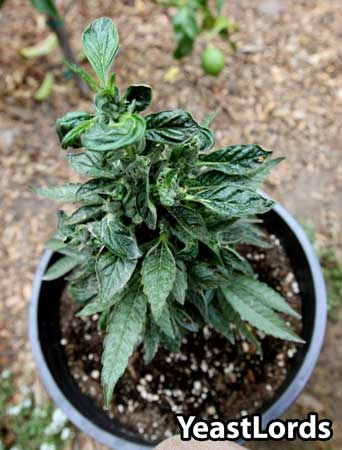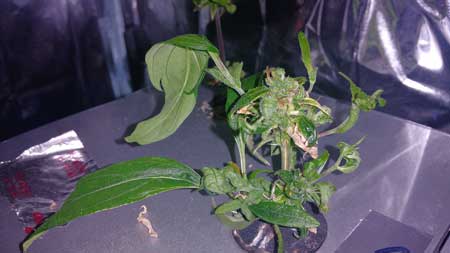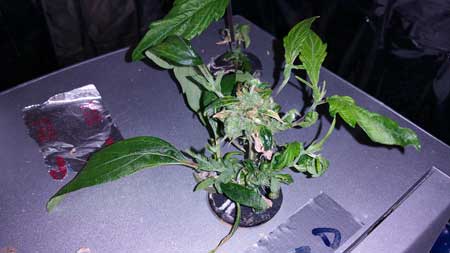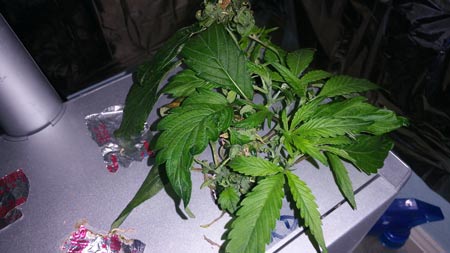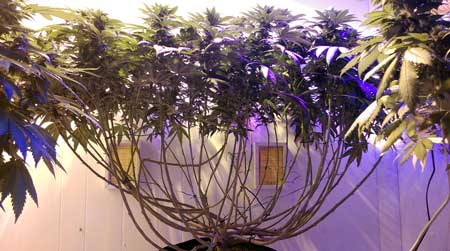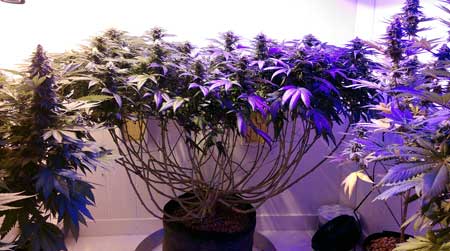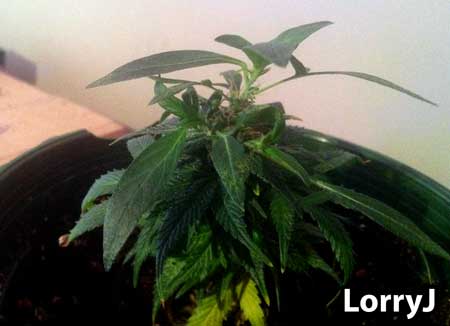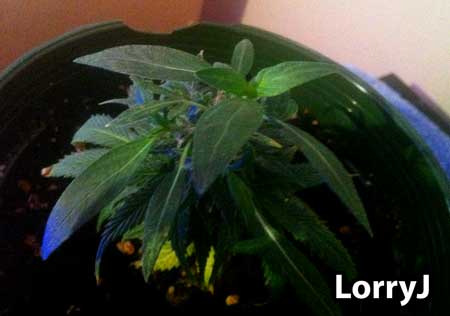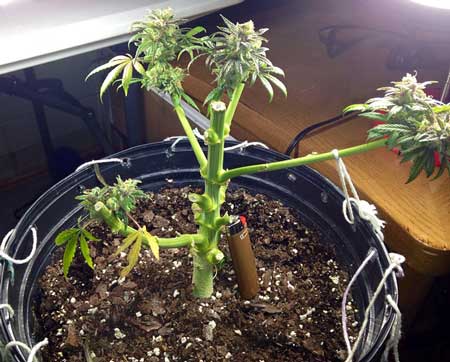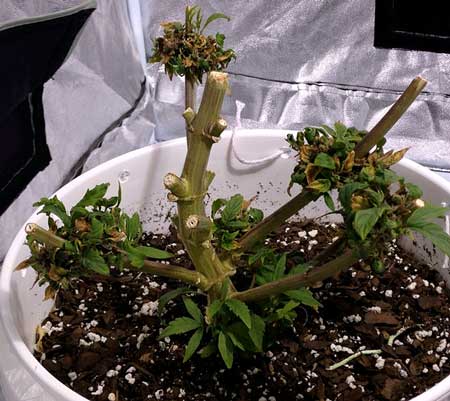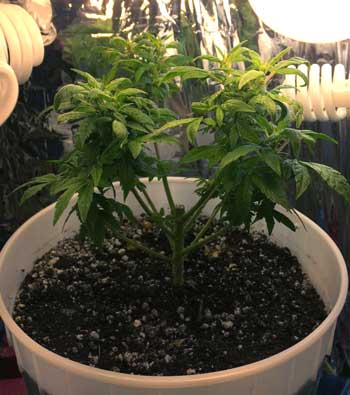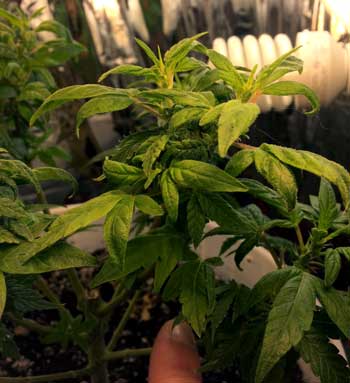by Nebula Haze
Table of Contents
- Re-vegging By Accident
- “Monstercropping” (Re-Vegging Cannabis Clones)
- Harvest Cannabis Twice (Re-Veg & Harvest Again)
Intro: What is Re-Vegging Cannabis?
“Re-vegging” cannabis (short for “re-vegetating”) is what happens anytime you take a cannabis plant in the flowering (budding) stage and revert it back to the vegetative stage. Cannabis plants that are re-vegging can display strange stretchy growth, single-point or 3-point leaves, and often grow round leaves with no serrations. However, some growers use a re-vegged plant’s unusual growth patterns to their advantage.
Example of a revegging cannabis plant – the edges of the new leaves are round instead of serrated. Not enough points per leaf.
Sometimes Cannabis Growers Re-Veg on Purpose…
- Monster Cropping – Take a cannabis clone from a flowering plant, a technique that is sometimes known as “monstercropping” (more on that below!)
- Harvest Plant 2nd Time – Re-grow a cannabis plant after harvest (typically not that productive as far as yields, but fun!)
A cannabis plant may be accidentally re-vegged due to various light schedule problems. Learn more about cannabis light schedules. For example…
- Light Leaks or Night Light in the Flowering Stage – Revegging is common when flowering cannabis plants are exposed to light during their 12-hour dark period, for example, if there’s a light leak in the grow tent, or if someone is occasionally turning the light on in the closet. Some growers may quickly check on their plants and not realize that even a few seconds of light can “confuse” the plant (unless you get a green light for gardening, which will not affect your plant’s dark periods). Outdoor cannabis plants can re-veg from the light of a window.
- Timer Not Working Properly – If your timer is somehow on the fritz, it may be giving your plants light during their 12-hour dar period, or irratic dark periods, which can cause plants to start reverting back to the vegetative stage. With some timers, you can accidentally hit a switch on the side that will keep it set to “on” all the time. So if you see re-vegging on your marijuana plants, check a few times a day and see if you can catch the light misbehaving, and if so, investigate or replace the timer.
- Changing Light Schedules Too Often – You can change your light schedule once in a while if absolutely necessary (you get a new job that has different hours so you need to check on plants at night now, for example) but changing light schedules too often can cause revegging and hermies to appear.
- Changing Type of Grow Light – I’ve seen re-vegging happen when moving a cannabis plant from the sun to LEDs, or changing from HPS grow lights to LEDs.
- Planting Outdoors Too Early – Putting cannabis plants outside at the wrong time of year can be a culprit. If a cannabis seedling is planted too early in the spring, it will start flowering almost immediately due to the short days but will start revegging when the days get longer. Wait to plant cannabis outside until mid to late spring to prevent this from happening.
- Changing Hands – When a plant is sold, traded, or otherwise changes hands, it’s not unusual to see signs of revegging if the plant is changing light schedules, and just going through the stress of a changing environment.
These cannabis plants were re-vegged by accident
Close to Harvest
Right After Being Brought Outside Too Early in the Year, Causing Re-Veg
Though the initial leaves grow in looking strange, the new leaves will start growing normally again a week or two after the plant is fully back in the vegetative stage.
“Monstercropping” – Cloning a Flowering Cannabis Plant
What is “Monstercropping?” It’s basically a fancy word someone came up with to describe what happens when you take a clone from a flowering cannabis plant.
This clone was taken from a flowering cannabis plant, notice the strange rounded leaves
Here’s the same plant 2 days later. It continues to grow new leaves with round edges and long stems while the plant is re-vegging.
Here’s that plant about a week later – at this point it’s already growing (mostly) normal leaves
Monstercrop cannabis pictures by Don B
In addition to the initial strange growth of the leaves, during the process of reverting back to the vegetative stage, a cannabis clone tends to grow much more bushy than normal with a strong tendency to create many side branches. Some growers prefer this pattern of growth and re-veg plants on purpose to try to create this effect.
Example of a Monstercropped Cannabis Plant
However, it seems the altered growth patterns only exist for the first few weeks after the switch to the vegetative stage, which can be a good or a bad thing depending on how the plant is trained. The changes in growth from monstercropping also seems to have a varying effect depending on the strains grown. In any case, you can override how your plant grows naturally if you use plant training!
This picture gives you a bit of an idea of the initial strange stretchy growth of a monstercropped cannabis clone. In the end this monstercropped plant yielded less than the other clones in the grow room.
Monstercropped Cannabis Pics by John Henry
If you’re already taking clones from a flowering cannabis plant for other reasons, that’s a great time to experience monstercropping for yourself so you can see what you think. However, from speaking with other growers who have monstercropped their cannabis plants, there seems to be a consensus that it’s not a consistent technique for getting the plant to branch out, so it should always be combined with other plant training techniques to make sure you get the results you’re looking for.
For what other reasons do growers take cuttings from cannabis plants in the flowering stage?
It’s common for a grower to want to take a clone from a particularly impressive plant before harvest. But when that happens, the clone must go through the process of reverting back to the vegetative stage before it will start growing again.
How to Take Clones From a Flowering Cannabis Plant
If taking clones from a flowering plant…
- Take cuttings from the bottom of the plant
- Make sure to pinch off any buds (may improve rooting speed; also, bud growth halts)
- Expect clones taken from a flowering plant tend to take a little longer to root compared to clones taken in the vegetative stage
This is what clones from a flowering plant look like after they start re-vegging, this is completely normal!
These plants will start growing normally again in 1-3 weeks
Harvesting a 2nd Time: Should you grow a cannabis plant again after harvest?
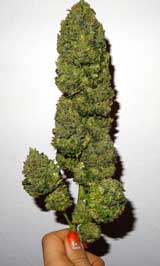
Unfortunately it’s not quite that simple. A cannabis plant is very “single-minded” in the way that it’s either growing buds or it’s growing stems/leaves, and not a lot in between. Unlike an orange tree which can produce leaves and oranges at the same time, cannabis plants tend to focus on making just one or the other. So since the plant is in “flowering” mode when the plant is harvested, you need to revert it back to the growing/vegetative stage (re veg the plant) before it will start growing again for your second harvest. This is because your plant will need to produce new budsites from which to grow bud.
During that process the plant will display some odd growth and possibly strangely shaped leaves, before it starts growing again, just like any other revegged cannabis plant.
One thing to keep in mind when re-growing a harvested cannabis plant is you’re still working with the “skeleton” of your old plant. Every part of the plant that you don’t cut off during harvest will remain with you. One of the really nice things about growing a cannabis plant from seed or clone, is it is so flexible and gives you the ability to train the plant however you want. It can be a pain to work with the ravaged shell of an old plant, instead of being able to get the plant to grow however you want.
This plant was just harvested, and a few branches were left to help the plant re-veg
Ideally, the grower would have removed the buds, since they will soon shrivel and die anyway (and you might as well harvest them!). When re-vegging a cannabis plant, it’s better to remove all buds, and make sure to leaves several leaves and growth tips. But even in conditions that aren’t ideal, the plant will usually recover and start growing even if it takes a little longer!
Here’s that plant 3 days later after being put on a 24/0 schedule, you can see the buds are dying but the plant has created several new leaves, some of which are smooth edged like a typical re-veg.
From this point on, new vegetative growth will continue to emerge from the green parts, and the plant can be grown again to a suitable size and re-harvested.
Benefits to re-vegging cannabis after harvest
- you don’t have to plant a new seed or clone
- possibly saved vegetative time
- no need to dispose of harvested plant
- re-vegged plants can grow back more bushy (sometimes to an extreme)
Downsides to re-vegging cannabis after harvest
- it can take a few weeks for a flowering plant to fully re-veg and start growing vigorously, and sometimes re-vegged plants just always grow slowly
- initial growth is strange and stretchy
- plant training is more difficult since you have to work with the “skeleton” of the old plant
- yields are often lower the second time around
If you do decide to re-veg a cannabis plant after harvest:
- During harvest, remove most of the plant including big branches, but make sure let the plant keep several leaves and a few “growth tips” where leaves are emerging. Your plant uses these to start forming new vegetative growth more quickly.
- Pinch off any buds on your remaining vegetative growth, so there’s only leaves and stems. If you skip this step your plant will still reveg, but you’re going to lose the buds anyway so why not harvest them? Plus it’s possible the plant may reveg faster if you remove the buds first.
- It’s normal for new growth to look strange, but the plant will start growing regular cannabis leaves after 1-3 weeks in the vegetative stage
Here’s one last example of a plant that was re-vegged after harvest 🙂
Closeup of the odd, round leaves. Every strain expresses re-vegging a little differently!
Read More About Revegging on Purpose (Monstercropping)
Jump to….
Monstercropping: Revegging on Purpose
7 Tips to Growing Top Shelf Buds
Which seed banks are safe for USA residents?
What do I need to get started growing weed indoors?
What’s wrong with my plants? (Diagnose them with pictures!)

